Leal Kindergarteners Are “Engineers-in-Training” Thanks to SWE’s FKO Outreach
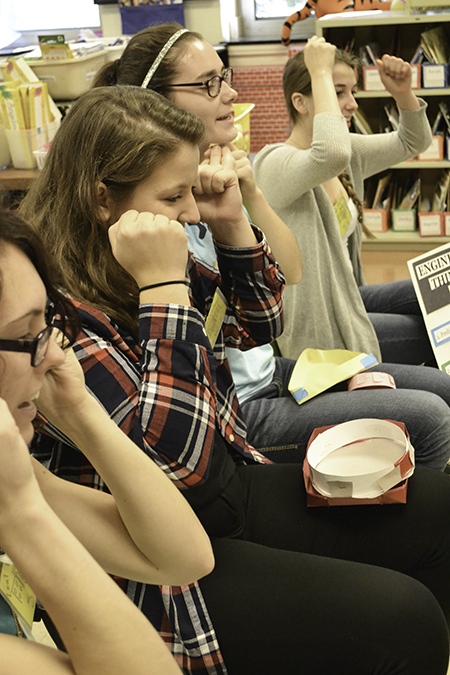
At FKO, SWE's weekly outreach to Leal School, SWE members Rebecca Boehning, Abby Pakeltis, Caitlin Haisler, and Molly McGiles demonstrate to the students how to put on their "Engineering Thinking Caps."
October 13, 2015
LaDonna Helm, kindergarten teacher at Leal School in Urbana, believes that of the 19 students in her kindergarten class…19 are potential engineers. So she brings in experts to help equip them: female engineering students from the University of Illinois who teach her students about engineering via the SWE (Society of Women Engineers) “For Kids Only” (FKO) program.
“I have been using the engineers for many years,” admits Helm, “for two reasons: one, because I feel like they’re experts in this field, as engineering students at the university.”
In addition, she believes partnering with the University, and SWE in particular, gives her class numerous added benefits. For one, her students receive instruction from authorities besides her. “And I also like the community partnership," she adds. "I think it’s a great opportunity for the students to learn from other people besides classroom teachers.”
One aspect of having the SWE engineering students teaching her class that she particularly likes is that she gets to be an impartial observer—to just observe her students and learn more about their strengths and their needs. She appreciates “just getting to kind of step back and look at it from a birds-eye view…I can’t do that when I’m teaching lessons.”

Leal Kindergarten teacher LaDonna Helm enjoys SWE's engineering presentation to her class.
Helm believes the FKO program is good for her young charges in a number of ways. For one, while her students are doing the fun, hands-on activities, they are also learning a lot about engineering.
“I think it’s having a positive, a tremendously strong impact. They are learning the engineering process from the experts in a way that maybe I can’t teach it to them. Also, it’s very developmentally appropriate;” she continues. “It’s hands-on; it’s fun!”
Plus, Helm believes the kids are gaining something even more important: the confidence that they, too, can become engineers:
“So, I feel that they are learning that it’s possible for them to be engineers. I feel like they are becoming pseudo-engineers themselves; engineers-in-training is what we call them.”
Helm also likes the fact that her students, especially the girls, are being exposed to women engineering students, to help break down the stereotype that engineering is only for men.
“The young ladies are role models for the girls, the kindergarten girls in the classroom. So the kindergarten girls can see that they too can be engineers. It’s a male and female profession.”
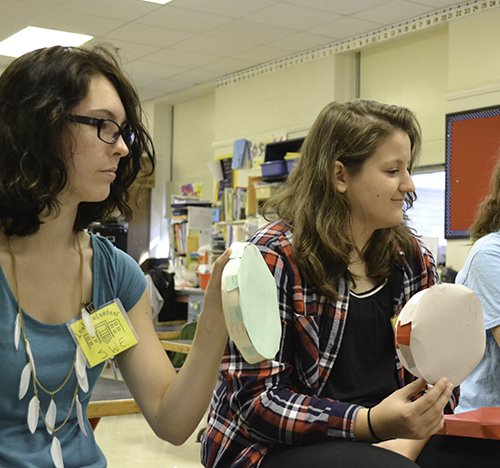
Rebecca Boehning and Abby Pakeltis hold up two structures so the kindergarteners can pick the one they thought was strongest. Leal kindergartener some engineering principles.
Like Helm, SWE member Rebecca Boehning, a junior in chemical engineering who is helping with FKO, also has the goal of changing the stereotype that engineering is only for men, and she believes that they’re making some headway.
“I personally believe we could see the impact from the first day,” Boehning relates. “One of the primary missions of SWE outreach is to change the perception that engineering is "for boys." On the first day, we explained to the class some of the things engineers do. Then we asked the children to draw pictures of an engineer and what engineers do. About half the class drew pictures of the other volunteers and me. Seeing that the children were drawing women as engineers made me feel like I was really making a difference.”
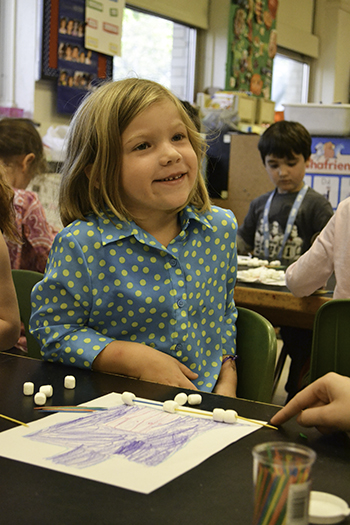
A Leal kindergartener interacts with one of the SWE engineering students.
Boehning's dream job is “to work on improving consumer products so that I can make things people use everyday better!” She also wants to inculcate into these students a similar dream. She says that’s why she’s participating in the outreach at Leal, because she wants to expose the students to all the positive things engineers can do.
“I'm hoping to show the children the power of science and engineering. I want them to know, even from this young age, that they have the potential to use STEM concepts to make the world better!”
Boehning says she participates in SWE outreach in order to give back to the community, but also to recruit more girls into engineering.
“Outreach is a fun way to give back to the community,” she says. “It allows me to take a step back from school work and help others, which I really enjoy. Specifically, I participate in SWE outreach because I want to empower young girls to pursue their passions in engineering.”
What kind of impact is FKO having on Helm’s students? Boehning reports that she and her SWE teammates are definitely showing the students how fun and exciting engineering can be:
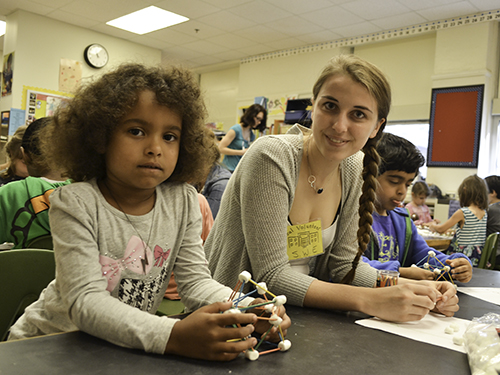
Above: SWE member Molly McGiles (center) with a Leal kindergartener (left) who has finished building a very sturdy marshmallow-toothpick structure.
“This is a fun, short event! The classroom is very engaged when we arrive, and their excitement from week to week makes me think that we are really showing the class how exciting engineering can be.”
Like Boehning, Caitlin Haisler, a sophomore in Mechanical Engineering, also hopes “to get these kids excited about science and engineering by showing them all the different applications engineering has on their lives and the world around.”
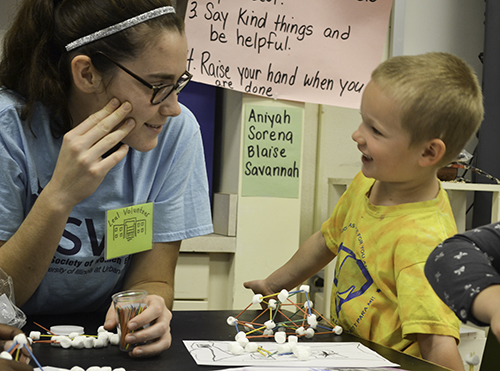
Mechanical Engineering sophomore Caitlin Haisler interacts with a Leal Kindergartener who has completed his marshmallow-toothpick structure.
Haisler’s dream job is "to work on a team at either Bell Helicopter or Boeing designing and perfecting the V-22 Osprey," (an aircraft that can take off and land vertically; it combines the functionality of a helicopter with the long-range, high-speed performance of a turboprop).
She admits that she’s participating in the Leal outreach in hopes of getting the kindergarteners to follow in her footsteps—to dream big.
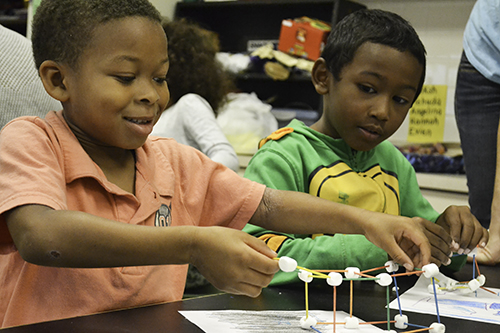
Two of Leal's potential engineers work on their marshmallow-toothpick structures.
"I want to encourage these kids to shoot for the stars. I want them to know that they are smart, and they can be whatever they want to be when they grow up. I don't want them to think science is boring or just too hard for them. If they want to build skyscrapers or planes, to design rocket fuel, or to cure diseases when they grow up, they can!”
Has the outreach been effective? Are there any future engineers in the class?
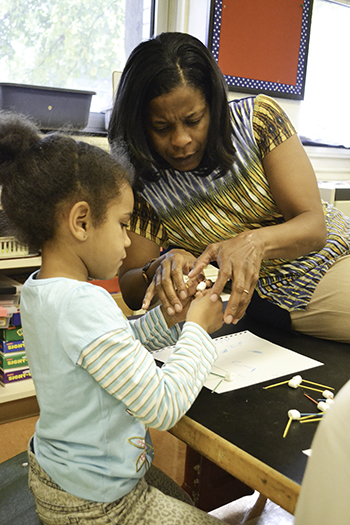
Ms. Helm (right) helps one of her students work on her structure.
Haisler says yes: “I'm definitely seeing some future engineers in this group. The kids are full of ideas and are extremely creative in the ways that they approach problems. I'm excited to see what they do when they get a little taller!”
Bohning agrees: “I think we definitely have potential engineers in this class. Several of the children seem especially passionate about science and engineering, and I hope we can fuel their excitement.”
Does Helm also see some future engineers in the group? “Absolutely!” She replies. “I do; I feel like they’re all engineers right now. We have potential—19 potential engineers.”
For additional I-STEM web articles about Leal, and also about SWE, see:
Story and photos by Elizabeth Innes, Communications Specialist, I-STEM Education Initiative
More: K-6 Outreach, Leal Elementary School, SWE, 2015
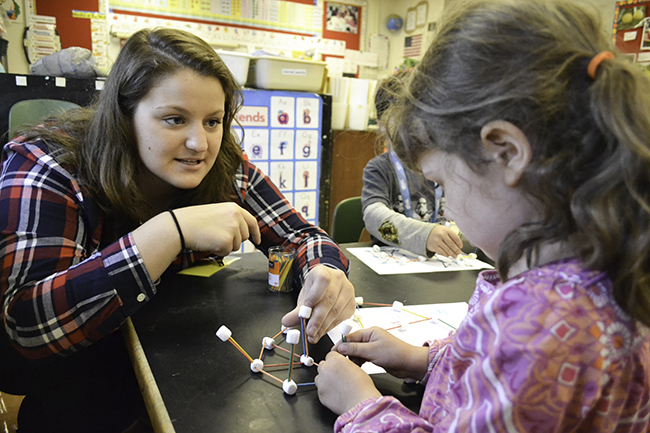
SWE member Abby Pakeltis interacts with a Leal kindergartener about the best way to build her marshmallow-toothpick structure.













.jpg)
















